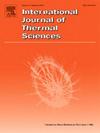Effect of pressure on the oil shale convection heating in-situ conversion process
IF 4.9
2区 工程技术
Q1 ENGINEERING, MECHANICAL
International Journal of Thermal Sciences
Pub Date : 2025-04-17
DOI:10.1016/j.ijthermalsci.2025.109940
引用次数: 0
Abstract
In-situ conversion technology represents the developmental trend for large-scale commercial exploitation of oil shale. High-pressure geological conditions significantly influence the pyrolysis kinetics of oil shale and the in-situ extraction process. This study conducted pyrolysis experiments on Qingshankou Formation oil shale from the Songliao Basin under varying nitrogen pressures, analyzing temperature fields, pressure fields, and oil production. Concurrently, CMG software was employed to simulate the in-situ extraction process through high-temperature nitrogen injection, evaluating the impact of pressure variations on extraction effectiveness from perspectives of reservoir properties, product yield, and energy utilization efficiency. Laboratory results indicated that increased pressure led to higher reaction temperatures and thermal losses, which would be expected to reduce the oil yield, but higher pressure reduced the risk of reservoir plugging, so that the observed oil yield was higher at higher pressure. Numerical simulations revealed distinct pyrolysis kinetics under high pressure compared to atmospheric conditions, showing elevated activation energy and reduced conversion rates with pressure increase. During high-temperature nitrogen injection, cumulative oil production and energy efficiency decreased under higher pressures. Consequently, the simulation indicates that excessive pressure inhibits the effectiveness of convection.
压力对油页岩原位对流加热转化过程的影响
原位转化技术代表了油页岩大规模商业化开发的发展趋势。高压地质条件对油页岩热解动力学和原位开采过程影响显著。本研究对松辽盆地青山口组油页岩进行了不同氮气压力下的热解实验,分析了温度场、压力场和产油量。同时,利用CMG软件模拟高温注氮原位提取过程,从储层物性、产率、能源利用效率等方面评价压力变化对提取效果的影响。实验结果表明,压力升高会导致反应温度升高和热损失增加,这将降低产油量,但压力升高会降低储层堵塞的风险,因此观察到的产油量在压力升高时更高。数值模拟表明,与大气条件相比,高压条件下的热解动力学特征明显,随着压力的增加,活化能升高,转化率降低。在高温注氮过程中,在较高的压力下,累积产油量和能源效率下降。结果表明,过高的压力抑制了对流的有效性。
本文章由计算机程序翻译,如有差异,请以英文原文为准。
求助全文
约1分钟内获得全文
求助全文
来源期刊

International Journal of Thermal Sciences
工程技术-工程:机械
CiteScore
8.10
自引率
11.10%
发文量
531
审稿时长
55 days
期刊介绍:
The International Journal of Thermal Sciences is a journal devoted to the publication of fundamental studies on the physics of transfer processes in general, with an emphasis on thermal aspects and also applied research on various processes, energy systems and the environment. Articles are published in English and French, and are subject to peer review.
The fundamental subjects considered within the scope of the journal are:
* Heat and relevant mass transfer at all scales (nano, micro and macro) and in all types of material (heterogeneous, composites, biological,...) and fluid flow
* Forced, natural or mixed convection in reactive or non-reactive media
* Single or multi–phase fluid flow with or without phase change
* Near–and far–field radiative heat transfer
* Combined modes of heat transfer in complex systems (for example, plasmas, biological, geological,...)
* Multiscale modelling
The applied research topics include:
* Heat exchangers, heat pipes, cooling processes
* Transport phenomena taking place in industrial processes (chemical, food and agricultural, metallurgical, space and aeronautical, automobile industries)
* Nano–and micro–technology for energy, space, biosystems and devices
* Heat transport analysis in advanced systems
* Impact of energy–related processes on environment, and emerging energy systems
The study of thermophysical properties of materials and fluids, thermal measurement techniques, inverse methods, and the developments of experimental methods are within the scope of the International Journal of Thermal Sciences which also covers the modelling, and numerical methods applied to thermal transfer.
 求助内容:
求助内容: 应助结果提醒方式:
应助结果提醒方式:


